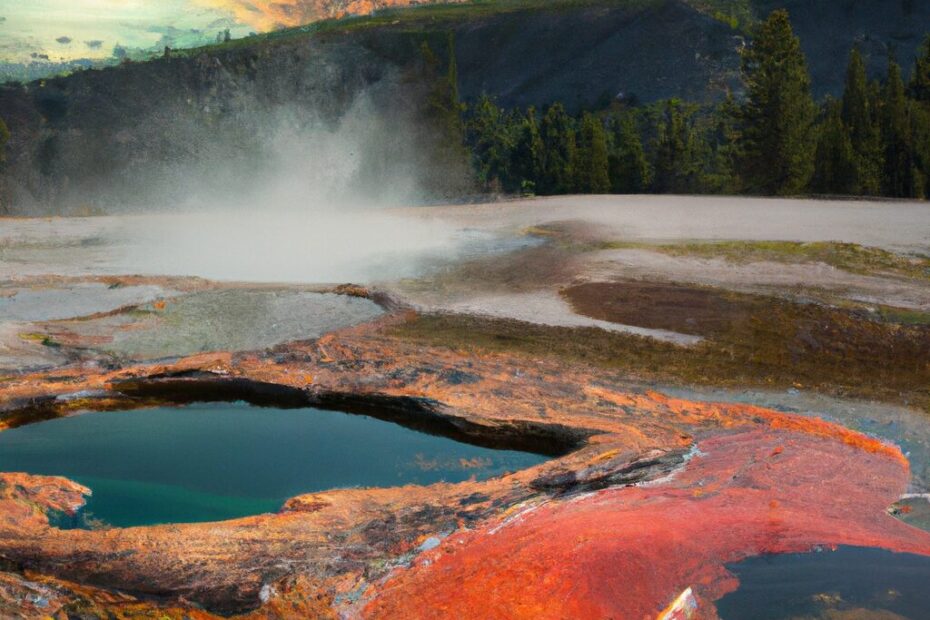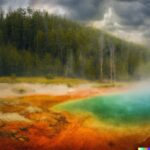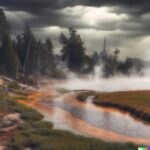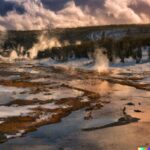Geysers are fascinating natural phenomena, characterized by their explosive eruptions of hot water and steam. But how are these geothermal wonders formed? And what are the main types of geysers that exist?
In this article, we’ll explore the captivating world of geysers, from their formation to their unique characteristics. We’ll also take a closer look at where geysers can be found around the world and what makes Yellowstone geysers so special. So, get ready to be amazed by the incredible geological structures and eruptive processes of these captivating natural wonders.
What Are Geysers?
Geysers are hydrothermal features that are characterized by intermittent eruptions of hot water and steam, often accompanied by colorful mineral deposits and unique geological formations.
Thermal pools are created when groundwater seeps down into the Earth’s crust and is heated by geothermal energy sources such as magma chambers. As the water becomes superheated, it rises through a vent, causing the explosive eruptions that characterize geysers. The mineral-rich water then cools and evaporates, leaving behind stunning terraces and formations that make up the unique landscapes surrounding these natural wonders.
How Are Geysers Formed?
The formation of geysers is closely tied to volcanic activity, involving the interaction of a heat source, geological processes, and the accumulation of underground water reservoirs under pressure.
This pressure can build up over time as groundwater seeps deep into the Earth’s crust, where it encounters the intense heat from nearby magma chambers. The heat causes the water to become superheated and pressurized, seeking a pathway to release the trapped energy.
The geological structure plays a crucial role, as it contains fissures and conduits that allow the built-up pressure to periodically erupt in spectacular displays of boiling water and steam, creating the iconic phenomena known as geysers.
What Are the Main Types of Geysers?
The main types of geysers include fountain geysers, cone geysers, and fountain-cone geysers, each exhibiting distinct eruption patterns and geological formations.
Fountain geysers are characterized by their tall, vertical eruptions, often reaching great heights and usually accompanied by a fan-shaped spray.
Cone geysers, on the other hand, are known for their conical mound formations surrounding the vent, which result from mineral deposits left behind by regular eruptions.
Fountain-cone geysers combine attributes of both fountain and cone geysers, with eruptions that feature a combination of vertical jets and surrounding mound formations, creating a unique spectacle.
Understanding these distinctive features adds to the fascination and appreciation of the remarkable geological activity of geysers.
Fountain Geysers
Fountain geysers are characterized by their frequent eruptions of hot water and steam, often creating expansive thermal basins and depositing vibrant mineral formations in the surrounding areas.
Geothermal features are a key factor in shaping the geological landscape. The regular outbursts of hot water and steam release built-up pressure from deep within the Earth’s crust, resulting in mesmerizing thermal basins.
The deposition of colorful mineral formations adds to the aesthetic appeal and scientific significance of these areas. The unique eruption patterns of fountain geysers showcase the dynamic relationship between the Earth’s internal processes and the formation of thermal features, contributing to our understanding of geothermal activity.
Cone Geysers
Cone geysers are known for their cone-shaped formations resulting from mineral deposits, and they often contribute to the creation of dynamic geothermal landscapes within their vicinity.
These cone-shaped geological features are the product of the continuous build-up of mineral deposits, primarily silica, from the geyser’s eruption. Their distinct shape sets them apart from other geothermal formations, creating a visually striking and remarkable landscape.
In addition to their aesthetic appeal, cone geysers also play a significant role in the formation of geothermal areas, influencing the flow and distribution of hot springs and geysers around them. Their influence shapes and defines the unique and diverse geothermal features that characterize these landscapes.
Fountain-Cone Geysers
Fountain-cone geysers combine the eruptive patterns of both fountain and cone geysers, resulting in remarkable geological wonders shaped by the interplay of their distinct eruption styles.
Geysers are known for their initial powerful burst, resembling a fountain, followed by the formation of a cone-shaped mineral mound. This is due to the accumulation of silica-rich deposits.
This unique combination creates a dynamic landscape, with repeated cycles of eruptions contributing to the formation of intricate terraces and basins in geothermal areas. The diverse patterns of these eruptions not only showcase the geological forces at work but also attract researchers and visitors alike to witness the captivating spectacle of nature’s artistry.
Where Can Geysers Be Found?
Geysers can be found in various locations around the world, with notable concentrations in places such as Yellowstone National Park, Iceland, and New Zealand, each offering unique hydrothermal landscapes and geothermal features.
Yellowstone National Park in the United States is home to the famous Old Faithful geyser, which regularly erupts with mesmerizing displays of boiling water and steam. This natural wonder attracts visitors from all over, eager to witness its powerful eruptions.
In Iceland, the geysers of Haukadalur Valley provide a captivating showcase of nature’s raw power. The most famous geyser, Strokkur, erupts every few minutes, shooting water up to 100 feet in the air. It’s a must-see for any traveler to Iceland.
New Zealand’s Rotorua region is also known for its impressive collection of geysers, hot springs, and mud pools. These geothermal wonders offer a glimpse into the earth’s inner workings and are a popular attraction for tourists exploring the country’s stunning landscapes.
Yellowstone National Park
Yellowstone National Park is renowned for its impressive concentration of geysers and hot springs, showcasing diverse hydrothermal systems and unique geological formations shaped by volcanic activity.
Yellowstone National Park is home to over 10,000 geothermal features, including geysers, mud pots, and fumaroles. These hydrothermal systems are a result of the park’s location over a supervolcano, which has led to their formation.
The park’s geysers are a particularly captivating sight, shooting columns of hot water and steam into the air at regular intervals. This unique display of nature’s grandeur is a must-see for visitors. Additionally, the impact of volcanic activity has created an environment where microorganisms thrive in extreme conditions, providing valuable insights into the origins of life on Earth.
Iceland
Iceland is home to a remarkable array of geysers, often associated with the country’s volcanic hotspots and characterized by their contribution to Iceland’s unique geothermal landscapes.
Iceland’s position on the Mid-Atlantic Ridge, a divergent tectonic plate boundary, is responsible for the formation of its geysers. The intense volcanic activity in this region creates the perfect conditions for these natural wonders to thrive.
As a result, visitors to Iceland have the unique opportunity to witness the raw power of nature as these geysers erupt with scalding-hot water and steam. This adds to the country’s diverse and captivating geothermal environment, making it a must-see destination.
New Zealand
New Zealand is known for its captivating geysers, which contribute to the creation of thermal wonders and serve as prominent features within the country’s unique geological and hydrothermal settings.
These geysers are a testament to the powerful forces at work beneath the earth’s surface, shaping the landscapes that have drawn visitors for centuries. They illustrate the dynamic nature of New Zealand’s thermal activity, offering a glimpse into the intricate balance of heat, water, and minerals that give rise to these remarkable natural phenomena.
The presence of geysers also highlights the significance of sustainable conservation efforts to protect and preserve these delicate ecosystems, making them a vital part of New Zealand’s environmental heritage.
What Makes Yellowstone Geysers Unique?
The geysers in Yellowstone National Park are particularly unique due to the combination of hydrothermal features, distinctive geological formations, and the impact of the Yellowstone Hotspot on the region’s geology and thermal activity.
These hydrothermal features result from the Yellowstone Hotspot’s influence, creating an otherworldly landscape and providing a rare glimpse into the Earth’s inner workings.
The formations of geysers like Old Faithful and the colors of the hot springs reflect the diverse mineral deposits and microbial life thriving in these extreme conditions. The constant activity and dynamic nature of these geysers make Yellowstone an unparalleled destination for witnessing geological wonders.
The Yellowstone Hotspot
The Yellowstone Hotspot is a key geological phenomenon that contributes to the abundance of geothermal resources and the formation of remarkable hydrothermal features within Yellowstone National Park.
This hotspot is responsible for the numerous geysers, hot springs, mud pots, and fumaroles that are found throughout the park. These hydrothermal features are not only visually spectacular but also play a crucial role in shaping the unique geological landscapes of the region.
The underground heat generated by the hotspot fuels the geothermal processes, creating a dynamic environment that supports diverse ecosystems. The geological activity associated with the hotspot has also contributed to the creation of the park’s iconic natural wonders, making it an essential part of Yellowstone’s allure.
Hydrothermal Features
The hydrothermal features in Yellowstone are shaped by a complex interplay of volcanic eruptions, hydrothermal processes, and the accumulation of superheated water, resulting in an array of unique geothermal landscapes and thermal wonders.
The features found in Yellowstone National Park are a result of the region’s geological activity, including volcanic eruptions that create underlying heat sources. Hydrothermal processes, such as steam vents, hot springs, and geysers, are fueled by the intense heat generated beneath the Earth’s surface.
Superheated water accumulates and contributes to the formation of diverse and captivating geothermal phenomena throughout the park, including steam vents, hot springs, and geysers. These features are a testament to the power and beauty of nature’s forces at work.
Superheated Water
The presence of superheated water within Yellowstone’s geothermal systems contributes to the creation of remarkable thermal pools, unique geological formations, and the emergence of diverse hydrothermal wonders.
This superheated water, heated by the underlying magma, plays a crucial role in shaping the landscape of Yellowstone. As it rises to the surface, it dissolves minerals, creating the vibrant colors seen in the hot springs and terraces.
The distinct microbial mats and thermophiles thrive in these extreme conditions, adding to the unique biodiversity of the region. The superheated water creates pressure that can lead to explosive geysers, such as the famous Old Faithful, captivating visitors with its impressive displays.
How Do Yellowstone Geysers Erupt?
The eruptions of Yellowstone geysers are primarily driven by the build-up of pressure, the release of thermal energy, and the geological structures that facilitate the intermittent release of superheated water and steam.
This build-up of pressure occurs as underground water, heated by the magma below, becomes trapped in narrow passages within the Earth’s crust. As the pressure increases, it eventually overcomes the resistance of the overlying rock and forces its way to the surface, resulting in the spectacular eruptions of geysers.
The release of thermal energy is a crucial part of this process, as the superheated water and steam escape, often reaching temperatures well above the boiling point. These eruptions are also supported by the intricate network of underground channels and fractures, allowing the superheated water to travel upward before being explosively released into the air.
Pressure Build-up
The build-up of pressure within Yellowstone’s geysers is influenced by the interaction of heat sources, the accumulation of superheated water, and the geological structures that contain and channel the pressurized hydrothermal fluids.
Heat sources, such as the underlying magma chamber, provide the energy necessary to superheat groundwater. As this water percolates through the subsurface rock layers, it collects in underground reservoirs, rapidly reaching temperatures well above its boiling point due to the immense heat.
The confined spaces created by the geological formations, such as fractures and fault lines, play a critical role in maintaining high pressure as the superheated water builds up. The combination of these factors creates the conditions for the spectacular geysers that Yellowstone is renowned for.
Thermal Energy
The release of thermal energy plays a pivotal role in triggering the eruptions of Yellowstone geysers. The interaction of superheated water with geological structures results in intermittent releases of hot water and steam.
This natural phenomenon is a captivating display of the Earth’s geological activity. The accumulation of thermal energy beneath the surface fuels the geysers, creating a spectacle of immense power and beauty.
Understanding the role of thermal energy in this process provides valuable insights into the Earth’s intricate systems and the connection between geothermal energy and the unique geological formations of Yellowstone National Park.
Geological Structures
The geological structures within Yellowstone’s hydrothermal areas play a crucial role in facilitating the intermittent eruptions of geysers. These structures provide channels and containment for the pressurized hydrothermal fluids, contributing to the emergence of thermal wonders.
Geological formations such as fractures, faults, and porous rock layers serve as pathways for hydrothermal fluids to reach the surface and form geysers. Impermeable barriers in the subsurface play a crucial role in accumulating and pressurizing these fluids, influencing the frequency and intensity of geyser eruptions.
The complex relationship between geological structures and hydrothermal processes creates the stunning thermal features that characterize Yellowstone’s distinctive geothermal landscape.
What Are the Most Famous Yellowstone Geysers?
Yellowstone is home to several famous geysers, including Old Faithful, Steamboat Geyser, and Grand Geyser. Each is renowned for their unique eruption patterns and distinct geological settings.
The geysers in Yellowstone National Park are a testament to the dynamic geothermal activity in the region. Among them, Old Faithful stands out for its consistent, predictable eruptions, shooting water and steam up to 185 feet in the air.
Steamboat Geyser, on the other hand, is known for its sporadic but powerful eruptions, making it the world’s tallest active geyser. Grand Geyser, with its impressive fountain eruptions, adds to the allure of Yellowstone’s geothermal wonders.
Old Faithful
Old Faithful is arguably the most famous geyser in Yellowstone, known for its predictable and spectacular eruptions, which serve as a testament to the region’s unique geothermal activity and natural wonders.
Visitors from around the world flock to witness its awe-inspiring displays, often marveling at the regularity and power of its eruptions.
As one of the most iconic symbols of Yellowstone National Park, Old Faithful stands as a reminder of the Earth’s incredible geological forces, captivating the imagination of all who encounter its mesmerizing shows. Its enduring appeal lies in its ability to showcase the raw, untamed beauty of nature, and it continues to hold a special place in the hearts of both nature enthusiasts and casual observers alike.
Steamboat Geyser
Steamboat Geyser is known for its remarkable geyser dynamics, including periods of heightened activity and impressive eruptions, contributing to its status as one of the most intriguing geysers within Yellowstone.
Its sporadic outbursts and immense power set it apart from other geysers in the park, captivating visitors with its unpredictable behavior. During its active phases, the eruptions can reach astonishing heights, creating a spectacle that leaves onlookers in awe. Its unique dynamics have puzzled scientists, adding an air of mystery to this already mesmerizing natural wonder.
The combination of its sporadic activity and the sheer force of its eruptions make Steamboat Geyser an iconic and unforgettable feature of Yellowstone’s geothermal wonders.
Grand Geyser
Grand Geyser is celebrated for its majestic formations and powerful eruptions, representing a stunning display of the geological wonders and hydrothermal features present within Yellowstone National Park.
Witnessing the towering plumes of water and steam as they shoot into the sky, observers are left in awe of the raw and untamed power exhibited by Grand Geyser.
Its eruptions can reach heights of up to 200 feet and last for several minutes, making it a captivating sight for visitors. The hydrothermal features surrounding the geyser add to its allure, showcasing the dynamic and ever-changing nature of Yellowstone’s geology.
Frequently Asked Questions
What is Yellowstone geyser?
Yellowstone geyser is a geological formation found in Yellowstone National Park in the United States. It is a hot spring that periodically erupts, shooting hot water and steam into the air.
How are Yellowstone geysers formed?
Yellowstone geysers are formed by a combination of heat, water, and pressure beneath the earth’s surface. The geyser’s underground plumbing system allows hot water to rise and erupt through the surface.
How many geysers are there in Yellowstone National Park?
There are around 500 geysers in Yellowstone National Park, making it the largest concentration of geysers in the world.
Are all geysers in Yellowstone the same?
No, each geyser in Yellowstone has its own unique characteristics, including eruption patterns, temperature, and duration.
Can you predict when a geyser will erupt in Yellowstone?
While some geysers in Yellowstone have regular eruption schedules, most are unpredictable and cannot be accurately predicted. However, park rangers can estimate the likelihood of an eruption based on previous activity.
Are there any safety precautions to take when visiting Yellowstone geysers?
Yes, visitors should always follow the safety guidelines and stay on designated boardwalks when viewing geysers. The water in geysers can reach temperatures of 200 degrees Fahrenheit and can cause serious burns.
Last Updated on January 25, 2024 by Jon Waraas – Originally Posted: January 25, 2024

I’m Jon Waraas, and I’ve been navigating the online world since 2006. By day, I’m the proud owner of some eCommerce gems, and by night, I’m the voice behind the adventures on Waraas.Com.
My heart, however, belongs to the wild beauty of Yellowstone National Park. I’ve got a collection of websites dedicated to sharing the wonders of this natural masterpiece. Oh, and did I mention? I’m currently building my own cabin inside the ghost town of Gilmore, Idaho – a cabin with tales to tell!
When I’m not immersed in the digital realm, you’ll find me lacing up my boots for a good hike or setting up camp under the star-studded sky.




